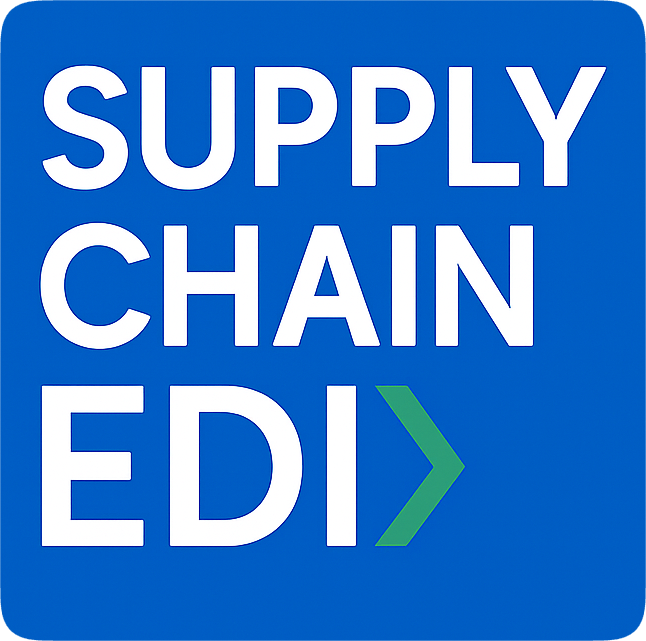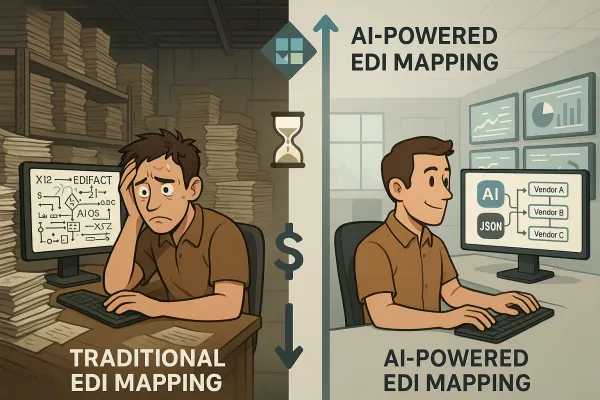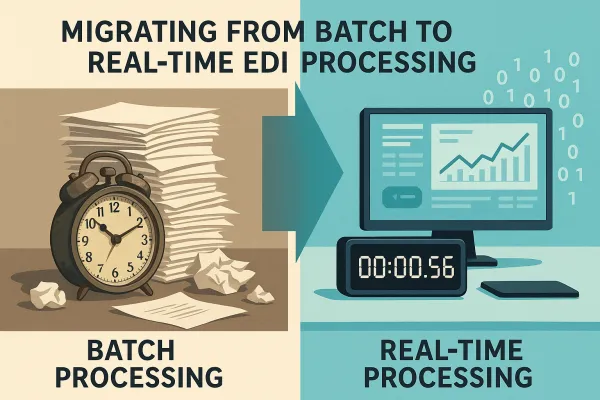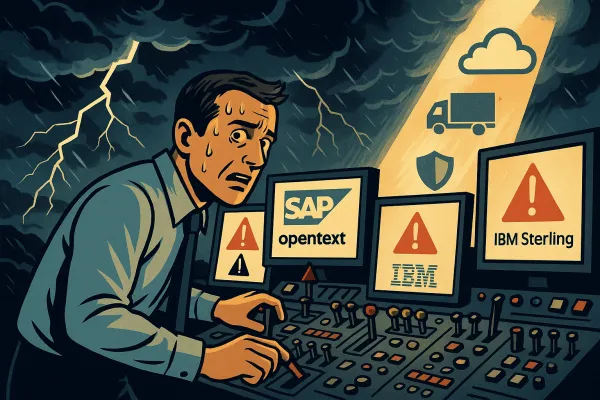The Quantum-Resistant EDI Implementation Roadmap: Protecting Supply Chain Data from Harvest Now, Decrypt Later Attacks in 2025
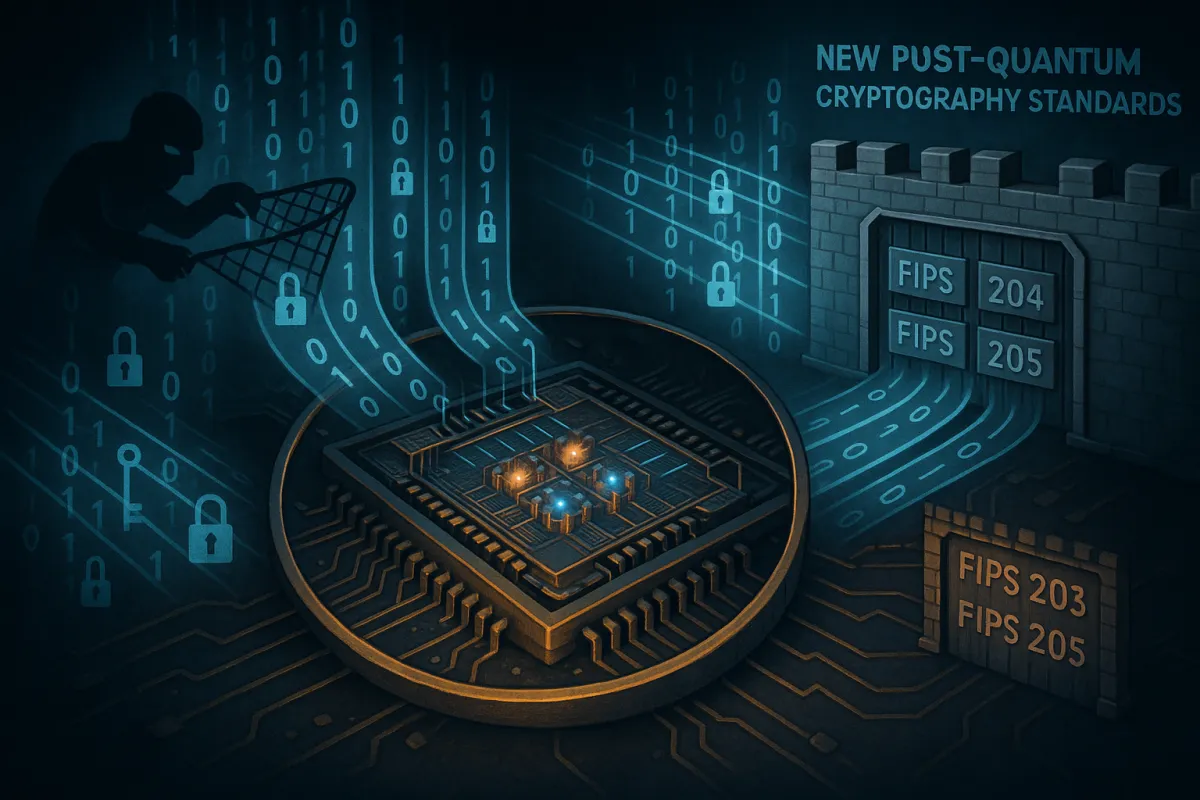
Your EDI systems are storing decades of sensitive supply chain data in encrypted silos, using RSA and ECC algorithms that will become vulnerable within 5-15 years. Experts estimate that a cryptographically relevant quantum computer could break current encryption within a decade, with some projections suggesting quantum computers capable of breaking RSA-2048 encryption may arrive by 2035. But attackers aren't waiting for quantum computers to become available.
Right now, bad actors are conducting "harvest now, decrypt later" (HNDL) attacks – collecting encrypted data today with the intent of decrypting it with quantum computers in the future. Your purchase orders, shipping manifests, supplier contracts, and transport schedules are being captured and stored, waiting for the day quantum computing catches up.
Understanding the Quantum Threat to EDI Systems
Quantum computers equipped with algorithms like Shor's can efficiently solve the mathematical problems that form the foundation of RSA and ECC encryption methods, rendering widely used encryption vulnerable to attacks. Here's what this means for your current EDI infrastructure:
Most asymmetric public/private keys used in key exchange processes are using RSA or elliptic-curve-based cryptography – the classical asymmetric algorithms that Peter Shor identified in the late 1990s as being vulnerable to being compromised by a quantum computer. Your EDI transactions rely heavily on these exact protocols for secure document exchange with trading partners.
Transport Layer Security (TLS) connections securing EDI transmissions use these vulnerable algorithms during the handshake process. State-sponsored actors will likely target data in transit, intercepting transactions and storing them while biding their time, then using quantum computers to factorize the asymmetric key pair, allowing them to expose the symmetric key and decrypt the data.
The "Harvest Now, Decrypt Later" Attack Vector
The idea is simple but powerful: Attackers collect encrypted data now, knowing that in the future, quantum computers may be able to break the encryption protecting it. In the manufacturing and supply chain sectors, several critical areas could be impacted, including supply chain management, quality control, logistics and transportation.
What makes enterprise businesses particularly vulnerable to HNDL attacks is the long-term value of their data. Sensitive customer information, proprietary research, and intellectual property can remain relevant and valuable for decades. If this data is harvested today, the damage caused by its exposure—even many years later—could be catastrophic.
Your EDI data includes supplier pricing agreements, demand forecasts, inventory levels, and strategic sourcing decisions. At the moment, trade secrets, business intelligence, and emerging technologies are the most at-risk data. Industries with long production cycles and significant R&D operations should take precautions against HNDL attacks.
NIST Post-Quantum Cryptography Standards for Supply Chain Applications
The algorithms announced today are specified in the first completed standards from NIST's post-quantum cryptography (PQC) standardization project, and are ready for immediate use. The three finalized standards include:
FIPS 203 (ML-KEM): The standard is based on the CRYSTALS-Kyber algorithm, which has been renamed ML-KEM, short for Module-Lattice-Based Key-Encapsulation Mechanism. This serves as the primary standard for general encryption, with comparatively small encryption keys that two parties can exchange easily, as well as its speed of operation.
FIPS 204 (ML-DSA): ML-DSA (derived from CRYSTALS-Dilithium) — a lattice-based algorithm chosen for general-purpose digital signature protocols.
FIPS 205 (SLH-DSA): SLH-DSA (derived from SPHINCS+) — a stateless hash-based digital signature scheme.
Additionally, NIST has chosen a new algorithm for post-quantum encryption called HQC, which will serve as a backup for ML-KEM, the main algorithm for general encryption. HQC is based on different math than ML-KEM, which could be important if a weakness were discovered in ML-KEM.
Major technology companies are already implementing these standards. Apple's iMessage and Zoom have begun implementing the new standards, namely ML-KEM. Cloudflare is also progressively enabling a version of ML-KEM, and Google Chrome is actively rolling out support for a hybrid KEM scheme.
Quantum-Resistant EDI Architecture Planning
Before migrating to quantum-safe systems, you need to understand your current exposure. Most enterprises underestimate how deeply encryption is rooted in their processes: customer databases, payment systems, APIs, cloud apps, employee devices, IoT sensors, and even printers. Mapping all systems and services that use RSA, ECC, or other classical algorithms is your first step.
Your EDI infrastructure assessment should include:
- AS2, AS3, and AS4 communication protocols
- FTPS and SFTP file transfer mechanisms
- VPN tunnels connecting trading partners
- Cloud-based EDI service providers
- On-premises EDI translation software
- Integration middleware and message brokers
Organizations must consider both direct quantum attacks against their systems and indirect vulnerabilities through supply chain dependencies. Third-party vendors, cloud service providers, and software components may introduce quantum vulnerabilities that require separate mitigation strategies. Comprehensive risk assessment extends beyond internal systems to encompass the entire technology ecosystem.
If your vendors use outdated cryptography, you inherit the risk. Plus, cloud providers and SaaS platforms are part of your encryption chain. If they lag on PQC, your data isn't safe.
Implementation Strategy for Supply Chain EDI Migration
A full shift to post-quantum cryptography won't happen overnight. That's where hybrid cryptography comes in. It's the bridge between today's classical systems and tomorrow's quantum-safe ones.
In practice, hybrid encryption means running both a classical algorithm (RSA/ECC) and a post-quantum algorithm together. Data is secured under both. If one fails in the future, the other still holds. This approach allows you to maintain compatibility with existing trading partners while adding quantum resistance.
Start with high-value EDI transactions: financial EDI documents (820, 997), advance shipping notices (856), and purchase orders (850). Start with hybrid TLS (Transport Layer Security) implementations, as many vendors already support it. Pilot hybrid models in high-value areas first, like customer authentication or financial transactions.
Organizations should begin quantum-ready encryption implementation immediately to ensure adequate preparation time before quantum threats materialize. Migration processes typically require 12-24 months for comprehensive deployment across enterprise environments. Legacy system integration challenges often extend implementation timelines significantly beyond initial projections. Early adoption provides crucial experience and identifies potential compatibility issues.
TMS and Multi-Carrier Shipping Software Considerations
Transport management systems require special attention for quantum readiness. Your TMS platforms handle sensitive routing data, carrier rate agreements, and real-time tracking information that remains valuable for years. Quantum computers could solve optimization problems far faster than today's best supercomputers, making them valuable for logistics, supply chain management, and defense applications.
When evaluating quantum-resistant solutions for transport management, consider platforms like Cargoson alongside other providers. The key is ensuring your chosen platform supports post-quantum cryptography standards for carrier integrations and API communications.
Multi-carrier shipping software faces unique challenges because you're integrating with dozens of carrier APIs, each potentially at different stages of quantum readiness. Your implementation timeline will be constrained by the slowest adopter in your carrier network.
Supply Chain Partner Onboarding for Quantum Readiness
Attackers love the back door: breaching a smaller vendor to get to a larger enterprise. So, add quantum readiness to vendor assessments. Ask how suppliers plan to adopt PQC. Update contracts to require quantum-safe practices for partners handling sensitive data. Prioritize critical vendors first, such as cloud, payments, and authentication providers.
Your trading partner agreements should include quantum readiness requirements with specific timelines. Many smaller suppliers won't understand the urgency until you make it a compliance requirement. Consider establishing a quantum-safe EDI consortium with your major trading partners to coordinate the transition.
Efforts like these demonstrate confidence in the security and performance offered by post-quantum algorithms for commercially available hardware — and also suggest widespread recognition of the urgent need for quantum-safe technology solutions across networks, software, and hardware.
Action Plan: 30-60-90 Day Quantum Readiness Implementation
First 30 Days - Assessment Phase:
- Complete cryptographic asset inventory across all EDI systems
- Identify RSA/ECC usage in AS2, FTPS, and VPN connections
- Survey trading partners for quantum readiness plans
- Contact EDI software vendors for post-quantum roadmaps
- Prioritize data based on long-term sensitivity (5+ years)
60-Day Mark - Planning Phase:
- Develop hybrid cryptography pilot program
- Test ML-KEM implementation with willing trading partners
- Update vendor contracts to include quantum-safe requirements
- Begin staff training on post-quantum cryptography
- Establish quantum readiness budget and timeline
90-Day Milestone - Implementation Phase:
- Deploy hybrid TLS for high-value EDI connections
- Implement quantum-safe VPN protocols for partner connectivity
- Begin migration of most sensitive EDI document types
- Establish quantum readiness KPIs and monitoring
- Create partner onboarding requirements for quantum-safe protocols
One of the most insidious aspects of HNDL attacks is that you won't know when your data has been stolen. Threat actors can capture encrypted data now and decrypt it years later once quantum computers allow them to do so. By then, the damage is irreversible.
The quantum threat to EDI systems isn't theoretical – it's happening right now through data harvesting. Your supply chain data has decades of value, making it a prime target for "harvest now, decrypt later" attacks. NIST is encouraging computer system administrators to begin transitioning to the new standards as soon as possible. The time to start your quantum-resistant EDI migration is today, not when quantum computers become mainstream.
